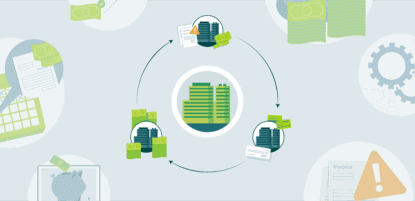The accounts payable (AP) department is responsible for financially managing a company’s liabilities. This includes paying vendors for goods and services, as well as managing employee expenses. Let’s take a look at the traditional role of the AP department, how that role is changing, and how businesses can structure their AP department to be more efficient and strategic.
The Traditional Role of the AP Department
The accounts payable department has a variety of responsibilities, all of which contribute to the financial health of a company. These responsibilities can be divided into three main categories:
Processing invoices and payments:
The accounts payable department is responsible for processing and paying invoices in a timely and accurate manner. This includes verifying that invoices are correct, coding them for proper accounting treatment, obtaining approvals, and ensuring that payments are made in a timely fashion.
Managing expenses:
The accounts payable department also plays a role in managing expenses. This includes reviewing expense reports to ensure accuracy and compliance with company policies. AP teams also work with employees to resolve any issues.
Reconciling accounts:
In addition to processing invoices and payments, the accounts payable department is also responsible for reconciling accounts on a monthly basis. This ensures that all transactions are properly accounted for and that the financial statements are accurate.
In addition to these primary responsibilities, AP team members often devote a significant amount of time to generating reports, managing cash flow, and working with vendors by responding to payment inquiries and updating their payment information, as needed. In fact, according to a recent MineralTree study, 42.5% of AP departments say they spend more than 6 hours per week answering vendor questions.
How the Role of AP is Changing
Traditionally, AP departments were primarily focused on getting bills paid and keeping accurate records. However, in recent years, the role of AP has shifted to become more strategic.
By automating manual and redundant AP tasks, accounts payable automation gives AP departments more time to devote to strategic tasks. This is especially important as businesses have become more globalized, expanding AP’s role to include managing cross-border payments and compliance with a variety of international regulations.
Another key change affecting AP teams is that more businesses are realizing the importance of a positive vendor relationship in a competitive market. 71% of firms noted that their supplier relationships have grown more important in the last year. This is likely due to supply chain disruptions limiting the number of competitive vendors with goods in the market.
The need to be strategic became even more important when the COVID-19 pandemic hit. Before, many businesses just paid invoices as they came in. Now, optimizing cash flow and carefully managing the budget means taking a more nuanced approach. Many teams use analytics solutions to analyze their payment mix and discover other money- and time-saving opportunities.
How to Structure Your AP Department
In order to be more efficient and effective, many companies adopt a centralized structure for their AP departments. Companies must also embrace the hybrid work model, invest in good data capture for analytics, and structure themselves for maximum flexibility and scalability. Here are five best practices to structure your AP department for success.
1. Embrace the Hybrid Work Model
Before the pandemic, 84.7% of workers were in the office full-time. Today, that number is 31.4%. In fact, 68.6% of AP teams are now either hybrid or fully remote. A hybrid or remote work model does not mesh well with paper invoices and manual AP processes. Instead, businesses should look for cloud-based AP platforms such as MineralTree that enable AP employees to work and collaborate from anywhere.
It’s also critical to move toward a paperless AP workflow so that processes aren’t impeded by employees and papers being in different physical locations. This means investing in an AP automation tool that includes invoice capture, making it easier to approve invoices digitally and migrate away from checks to electronic payment methods.
2. Invest in Good Data Capture For Analytics
One of the benefits of accounts payable automation is that it can help capture data more effectively. This data can then be used to generate reports to improve your AP process. With an AP automation solution such as MineralTree, teams can use invoice data once as soon as the information has been captured, instead of waiting for invoices to be posted to the ERP system. Since information can be used at an earlier date, your team will always have access to an accurate and updated view of the company’s current financial standing.
Some things to consider when investing in data capture and analytics tools include:
- The type of data you want to capture (e.g., invoices, payments, etc.)
- The format you want the data to be in (e.g., Excel, CSV, etc.)
- The frequency with which you want to update the data (e.g., daily, weekly, monthly, etc.)
Once you have decided what type of data you want to capture and how often you want it updated, you can then start looking for a tool that meets your needs. There are a variety of accounts payable automation solutions on the market, so be sure to do your research before making a decision.
3. Enroll Strategic Vendors in Electronic Payments
Electronic payments (ePayments) offer a wide array of perks to AP teams, but there is a common misconception that vendors don’t want to switch to ePayments. In fact, 57% of AP teams noted a supplier’s unwillingness to accept ePayments as the top obstacle to converting more spend to ePayment methods. Unfortunately, a similar misconception also exists amongst suppliers, 63% of whom report customers’ unwillingness to move away from checks as the top obstacle to ePayment adoption. Ironically enough, when asked, 82% of suppliers said they would like to receive more ePayments, meanwhile 71% of AP teams intend to convert more spend to ePayments over the next 12 months.
There are many perks to ePayments for both parties; vendors benefit from electronic payments since they get more visibility into the payment process and increased security. MineralTree even handles enrollment for you, contacting suppliers on your behalf and setting up electronic payment methods. They can also determine which vendors already accept ePayments from their existing list of suppliers.
4. Centralize Your AP Documentation for Easy Accessibility
If you have a decentralized AP structure, documentation can be spread out across different departments and physical locations. This makes it difficult to keep track of what’s been paid and what hasn’t, let alone find invoices when you need them.
A centralized AP documentation system can help with this issue by providing a single location for all AP documentation. This way, you can easily see what’s been paid and what hasn’t, as well as find invoices when you need them. A good accounts payable automation solution will include a centralized documentation feature so that you don’t have to worry about losing track of important documents.
5. Ensure Scalability
Another way to ensure that your AP department is efficient and effective is to structure it for maximum flexibility and scalability. This means having a department that can easily adapt to changes in your business, as well as one that can expand as your business grows.
The key way to do this is to use an AP automation solution. According to the MineralTree survey, 61% of those who have invested in AP automation are now processing more invoice payments with the same size team.
Case Study: BrightView Improves their AP Process with MineralTree
BrightView, an outpatient treatment provider, was able to streamline and speed up their entire AP process by adopting MineralTree. According to Controller Matt Santell, “All of the invoice data is in one place, so we don’t have to look for it anymore. We have a standing meeting with the CFO to review each week’s payables. It’s so easy to review and this new approach has improved our ability to do long-term planning.”
Structuring Your AP Department with MineralTree
The accounts payable department plays a critical role in today’s businesses, but its role is changing. To stay ahead of the curve, it’s important to structure your AP department for maximum efficiency and flexibility. Accounts payable automation solutions can help you achieve this by providing a centralized documentation system, enabling easy scalability, and managing vendor enrollment for electronic payments.
MineralTree is here to help you succeed. Our platform not only syncs with your current ERP system, but makes ePayment enrollment and initiation easy, enables electronic invoice approval from anywhere, and provides the data and analytics you need to continuously improve efficiency – without adding headcount.
Ready to restructure your AP department? Request a free demo today to learn more.




